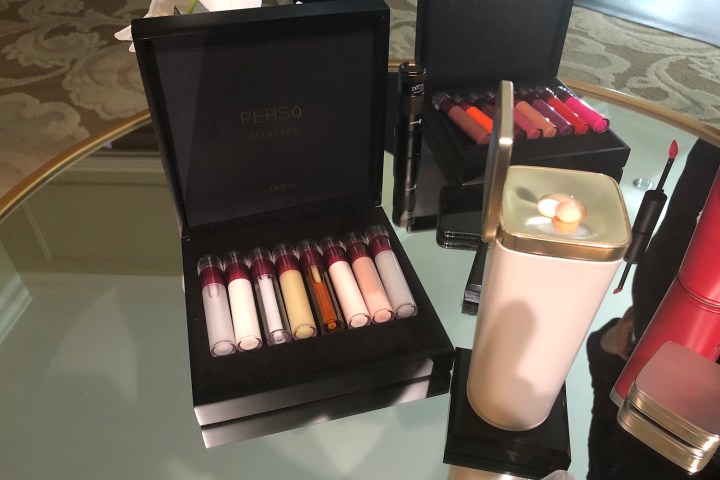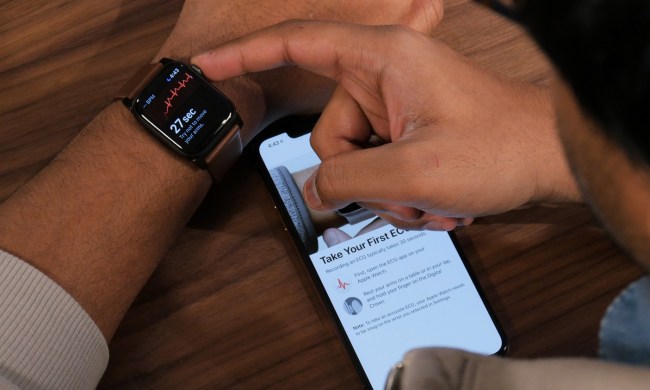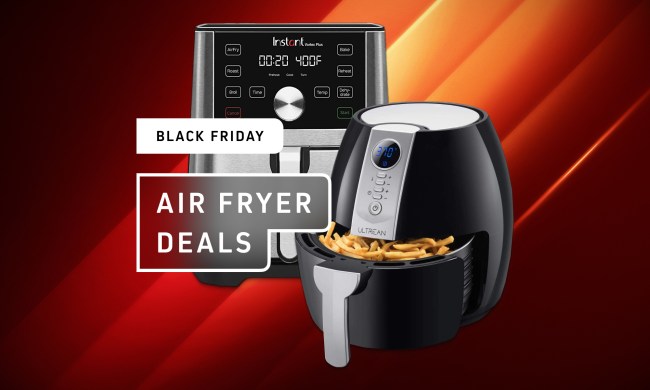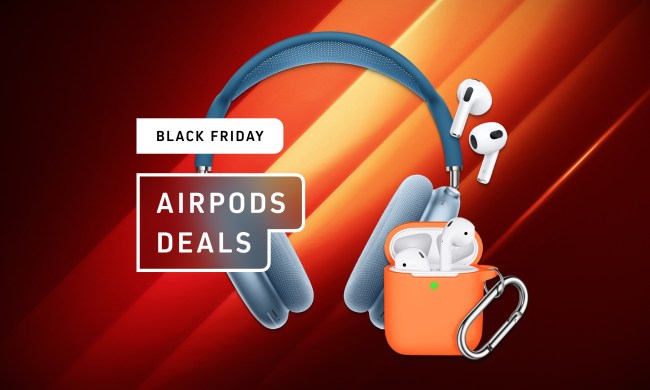At last year’s Consumer Electronics Show, beauty companies eked their way onto some of the bigger show floors. CES 2020 proved that not only do these companies deserve their place at the show, but they’re turning into tech companies year-round. From L’Oreal to Neutrogena to Proctor & Gamble, big brands are churning out devices and apps that don’t even necessarily adhere to the women-only label many put on beauty companies.
Many of these companies have been embracing tech for years, but their presence at CES comes as skincare aficionados have more access than ever to information about ingredients and products. Companies like Deciem have made it easier to buy individual ingredients like hyaluronic acid, which hydrates skin, at low prices. It’s allowed people to personalize their own routines, mixing in a drop of one serum into their favorite moisturizer, then adding a different one come nighttime.
Moisturizer, made for you
Anyone who’s played with a shoddy augmented reality app in the past may be familiar with the tendency for you to turn your head and leave what looks like a superimposed animal mask behind. Beauty brands like Perfect Corp. have helped improve the technology so that when you move your mouth, you don’t lose the Ruby Soho lipstick you’re testing out in the app. Virtual makeup is essentially smudge-proof.
L’Oreal wants to perfect this kind of augmented reality, and bring it into the real world, with Perso, its smart beauty device, which has been in development for six years as part of the company’s Tech Incubator.
At CES, I got a demo of how it helps you create a unique shade of lipstick: For now, it’s based on a curated list of Instagram trends. Scroll through a feed of photos and select someone wearing a color you’d like to try. The app will show you a few swatches to choose from, and then when you select, the color shows up on your lips — and stays there as pucker or laugh uncomfortably at suddenly being on camera.

The really exciting part is what comes next. Tap a button and the Perso will suction liquid from three cartridges. Each cartridge doses the top the proper amount of each color, so when you mix them, the result will match reasonably close to the color in the app. You can also detach the top of the Perso and have a little carrying case with your new lip color to tote around.
“You can be part of a trend but not have to buy a new product to do it,” Guive Balooch, the Incubator’s global vice president, told me.
Perso can even upgrade your skincare routine: Using photos, it analyzes your face for under-eye wrinkles, firmness, pore size, and more. Based on the qualities of your skin you want to change, the Perso will pull a personalized mixture from cartridges that contain serums, moisturizes, and skin protectants.
It even takes your local climate into consideration: Since I was getting the demo in the desert known as Las Vegas, the Perso oozed out more moisturizer compared to the other ingredients. In a high-pollution environment, the device will add more antioxidants.
During what Balooch calls onboarding, you’ll be able to tell the Perso app whether you like a thinner or thicker moisturizer, or it can give you recommendations if you’re unsure. If your goal is to get more glowing skin, you might start seeing results in a few weeks, Balooch said. Reducing wrinkles is a longer process, but he thinks that keeping track with app will keep people from getting discouraged.
Depending on how often you use them, the cartridges should last between three months for the lip color (for twice-a-day users) and two to three months for skincare solutions.
Saving face
Someone regularly using the Perso is going to be feeding a lot of information to the app, including images. “We never link the personal data of consumers to the progress of their skin,” Balooch said. He gave the example of Lancôme’s Le Teint Particulier. The device’s camera takes photos of your skin, analyzes them, and then creates a foundation that matches your skin tone. The company, which is a L’Oreal brand, doesn’t keep this color associated with your name and email address.
The Perso won’t be available for at least another year, and Balooch isn’t sure which L’Oreal brand will actually debut the device. He envisions everything from Lancôme to Maybelline having compatible products. “Our commitment is that for that volume, in the brand, you will not have to pay more for it than you would for a normal product,” Balooch said, “but you have a lot more options.” Presumably, that doesn’t factor into the cost of the Perso itself, which has yet to be set.
Of course, those NFC cartridges do mean the Preso won’t allow you to dabble in non-L’Oreal brands — much like how it took Keurig a while to let you add your own coffee grounds to its machines. While the company has diverse options for luxury and budget, I don’t know anyone gets every product from a single source. For those of us who might buy an affordable moisturizer and dress it up with sparing droplets of expensive serum from an entirely different company, the Perso’s restrictions might keep tech-supported personalization out of reach.
Facing the facts
Neutrogena is also trying to personalize your skincare routine, while also letting you stay open to other brands. Its Skin360 app and $60 Skin Scanner device launched in 2018. At the time, the company said you needed the extra device to take images accurate enough to analyze your skin. Now, you can just use your phone.
“Being able to look at the detail of the skin at a close enough level, that we weren’t able to do two years ago,” said Tyler Rochwerg, a digital marketing and innovation manager for Neutrogena said.
The relaunched app is looking for much of the same skin metrics as the Perso app. The Skin360 app grades you on a scale of 1 to 10. “There is no bad score,” said Kathryn Drehs Sauers, associate director of global strategic insights at Johnson & Johnson, when I asked how this type of rating might affect people’s self-perception in an age of low selfie-esteem. Instead, you’re supposed to view the app as a learning tool, a place to get recommendations on how to improve your dull skin or dark spots, or whatever issue is plaguing you.

Some of these seemed to overlap; if you choose smoother skin, doesn’t that also mean fewer fine lines? Wouldn’t hydrating your skin help with that? To be more inclusive, the app doesn’t ask for your gender but instead asks if you shave regularly or use products designed for men. Based on your answers and the images, the app then creates your day and night regimens.
The suggestions aren’t meant to be quick fixes. NAIA, the app’s artificial intelligence-driven coach, is meant to take you on an eight-week journey. That may not be enough time to combat years of neglecting sunscreen, but again, Neutrogena hopes the feedback and any progress you see will encourage you to stick with it.
You can even track your progress with non-Neutrogena products. Rochwerg showed me how he’d added an Aveeno sunscreen he uses, for example. While the app gave me links to five products for my regimen, Drehs Sauers said it’s very unusual for people to buy everything on the list.
In addition to suggesting Neutrogena products, the app is also supposed to give you insight into what products are good for you. There are lots of tailored articles, based on your scores and what areas you said you want to improve. “That’s what a lot of this content and articles provide, are those digestible nuggets to really empower you as a consumer to better know what’s right for you,” said Drehs Sauers.
The photos you snap with the app are supposed to speak for themselves, without taking into account the age you enter, as you see with many other apps. However, when Rochwerg uploaded my photos for the demo, my wrinkle score was 9.9. The higher your score, the less you need to worry about it.
Overall, my score was 8.6 out of 10. When I tried the app myself later, I got a different picture. (I also used different photos.) My wrinkle score had plummeted to 8.7, taking my average score to 8.1. The rest of my scores varied between 0.1 and 1.3 points. Maybe the lack of sleep from the night in between took more of a toll than I realized. The next day, on a full eight hours of sleep, my wrinkles were still the same, but my dark circles were at an all-time low of 5.8. (Still rated “good,” according to the app.)
As I was playing around with the app after leaving the CES show floor, I did notice a button under the “settings” tab, asking if I wanted to opt out of letting Neutrogena sell my data. I clicked it, was taken to a website, and had to submit my request. A screen popped up, telling me the company will review my request and contact me shortly.
Where the boys are
Because CES is such a male-dominated event, it was interesting to see the reaction one piece of beauty tech generated among my male colleagues. The Opté Precision Skincare System is a device that’s a bit like a printer for your skin. Roll it over your arm, and it will deposit a foundation-like substance only where it detects dark spots. The serum comes in three shade options but each matches a wide variety of skin tones –it will cover 99% of complexions, according to the company. I saw it in action with John Velasco, Digital Trends’ Home Editor. He called it Photoshop in real life.
Jeremy Kaplan, our editor-in-chief, said he might actually use it, precisely because it doesn’t seem like makeup. You don’t have to put any product where you don’t need it. The $599 price tag is definitely far from affordable for the average person, but it’s the kind of tech that may make some men rethink their stance on makeup.
Beauty products have always been some of the most mysterious in the drug store. You know within about an hour if your cold medicine isn’t working. The tech-driven personalization trend may give people more control over what they’re putting on their faces, but the trade-off could be giving up more data, more unsettling information gleaned from our selfies, and higher prices for novel devices.


